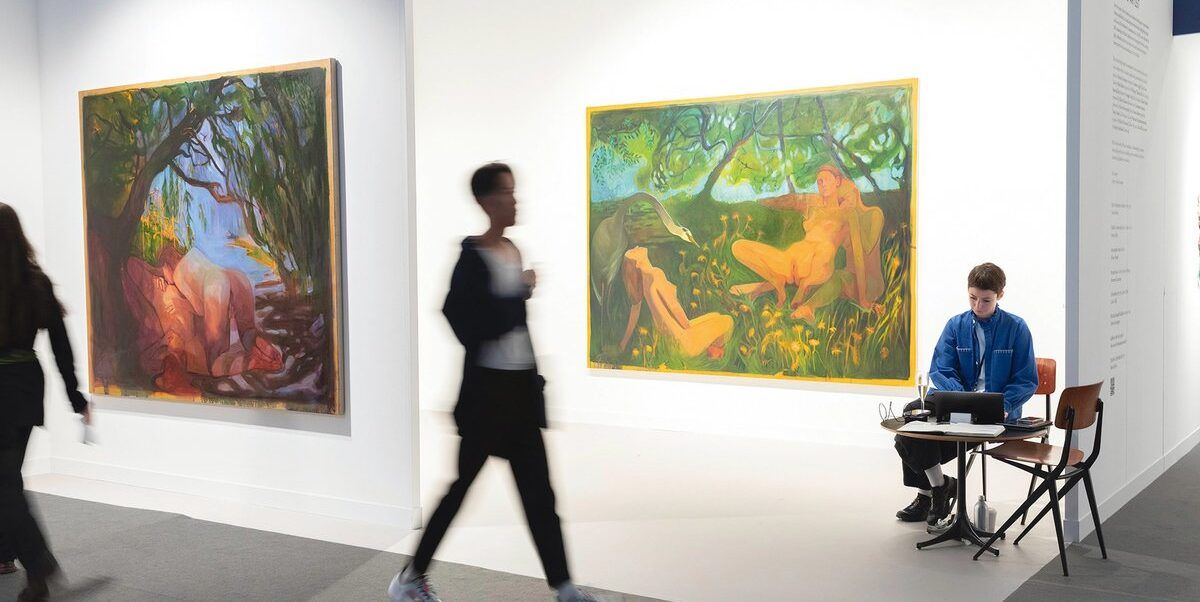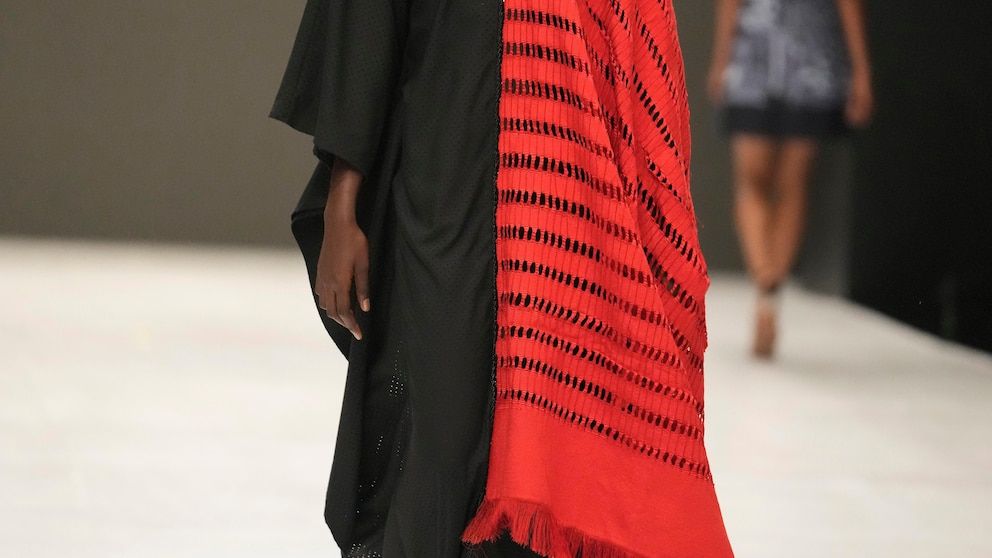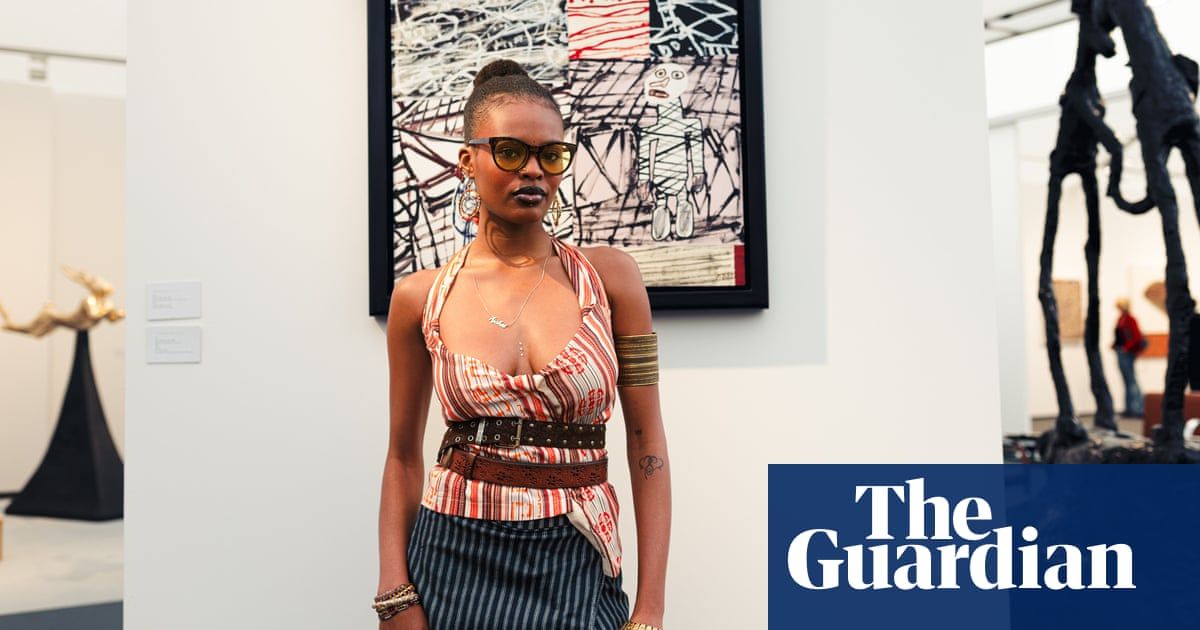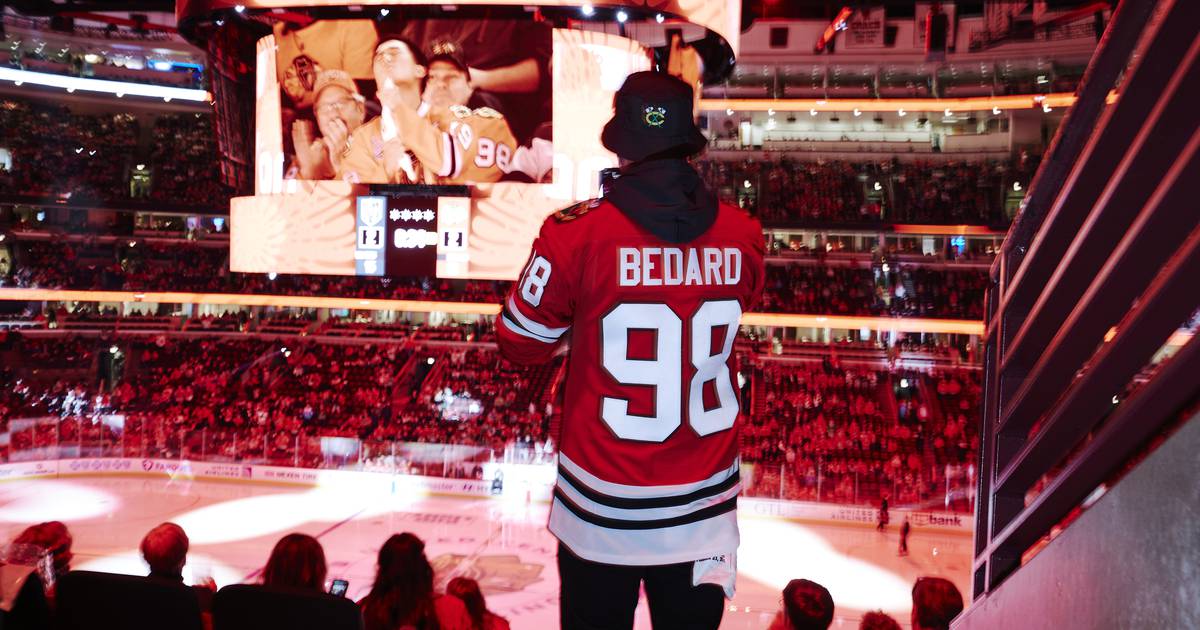Are we witnessing the comeback of the carnal in contemporary art? It would be too extreme to say that Frieze London’s aisles of white cubes double as a red-light district; the vast majority of the works on offer this week are still family-friendly. But consenting adults willing to look a bit closer will find a small but strong undercurrent of pieces unafraid to embrace eroticism, particularly among ascendant artists born after 1980. And most notably in this uneven moment in the market, sex is indeed selling.
The hardest-to-miss entries are the monumental paintings by Vanessa Raw in Frieze’s first Artist to Artist section, a group of eight stands curated by eight major artists spotlighting lesser-known talent. Selected by Tracey Emin (whose complex in Margate houses Raw’s studio), the canvases portray lusty encounters between nude women in Eden-like natural surroundings populated by allegorical animals, such as the heron (symbolising self-reliance and strength) and the serpent (symbolising temptation).
Personal explorations of desire
Raw’s latest body of work is both an extension of, and a radical departure from, several years’ worth of less provocative portraits and landscapes. Georgie Scott of Carl Freedman Gallery frames the new paintings not as political statements but rather as “very personal” explorations of desire and vulnerability. The four paintings in the Artist to Artist stand had been placed by day two of the fair, at prices from £16,000 to £25,000; six other large paintings from this body of work had sold, also at £25,000, by Friday, including one to an American collector with a private institution. Carl Freedman will host a one-person show of Raw’s work in 2024.
Croy Nielsen’s stand in the Galleries section features works by two Vienna-based artists engaging with eroticism head-on. On the back wall of its stand, the gallery has installed an untitled 2023 canvas by Polish-born Joanna Woś, who channels stills from porn videos and motifs from Renaissance painting into psychosexual dramas about the unsettling dynamics of power and pleasure. In this case, scenes that ambiguate soft bondage and forced captivity bristle against elements referencing Piero della Francesca’s The Baptism of Christ.
Look left of Woś’s painting to find Japanese-born Soshiro Matsubara’s You, who are alive, are always far away and keep me alive (2022), a mixed-media sculpture invoking a bizarre tangent in the life of the Austrian Expressionist Oskar Kokoschka. Three years after the end of an intense affair with Alma Mahler, Kokoschka commissioned an avant-garde doll-maker to create what the Metropolitan Museum of Art terms an “anatomically accurate, three-dimensional likeness” of her “onto which he could displace his irrepressible amorous desires”. Matsubara uses painted ceramic and artificial hair to render both the Mahler doll, reclining on a plinth with its legs splayed open, and a man’s head attached to the floor with its tongue extended toward (but hopelessly distant from) what Courbet euphemised as L’origine du monde.
According to Cara Lerchl, the director of Croy Nielsen, Woś’s compositions deliberately invert the male gaze, making women active agents in pictorial narratives where they have too often been made passive. Matsubara, meanwhile, is “obsessed” with the Viennese Modernists, particularly Kokoschka and Egon Schiele—no strangers to steering their studio practice with their libidos. “In Vienna, we see a lot of art” in this tradition, she says, postulating that the new generation’s interest in racy themes stems from a desire for “liberation from a certain conservatism” building in the wider world. The Woś painting, priced at €20,000, found a buyer early, but the Matsubara sculpture, priced at €16,000, was still available by Thursday’s end.
One-off examples aimed at a blue-chip audience furthered the randy renaissance. Michael Werner sold a large painting by German-born, New York-based artist Florian Krewer that comes from an ongoing body of work whose scenes resemble a low-rent version of the Stanley Kubrick film Eyes Wide Shut. Here, a man in a carnival mask, jeans and T-shirt ogles a woman in stiletto boots with her panties dropped and a blindfold in one hand. Carlos Ishikawa pre-sold a canvas by Issy Wood, Me reading playgirl 1993 (2023), that shows the artist’s hand caressing the torso of a nude male model in a vintage issue of the adults-only American magazine, while her trainer playfully covers his pelvis. (Neither gallery disclosed sale prices.)
Young artists in the middle market are embracing the erotic. “Some of our artists are definitely going in that direction,” says Esther Kim Varet, owner of Various Small Fires gallery, when asked about the surge in steamy content. “I wonder if, for figurative painters, it’s the final step before abstraction, really pushing the viewer’s senses to the maximum degree before obliterating the image altogether.”
Wrestling—or foreplay
The Various Small Fires stand includes Alex Foxton’s sensual, lavender-hued portrait of Saint Sebastian, long an icon in the gay artistic community (priced at $35,000), as well as two classically inspired paintings by Mark Yang ($42,000 each) showing groups of muscular nude men entangled in what could be either wrestling matches or rough foreplay. All three works found buyers by Friday morning.
Varet will open a solo show by Alina Perez featuring charcoal drawings of intimate scenes at Various Small Fires’s Dallas space on 4 November. The challenge inherent in staging the exhibition in Texas, whose state government has radically restricted women’s access to reproductive healthcare, is not lost on the dealer. She too wonders if some of the energy being directed toward explicit sexuality is about artists and gallerists “figuring out how to assert our right” to expression and liberal values in response to puritanical political pressure.

Danielle Mckinney’s Hindsight (2023) © the artist, courtesy of the artist and Marianne Boesky Gallery
Adjacent to Various Small Fires’s stand, New York-headquartered dealer Marianne Boesky continues the trend with a solo presentation of Danielle Mckinney. Mckinney has amplified the carnal charge in some of her latest portraits of young Black women in private moments of leisure and pleasure (as well as various states of undress). Whether reclining nude on the back of a stallion or baring a lithe leg as cigarette smoke curls around a darkened reading room, a subset of these images smoulder precisely because Mckinney grants her subjects such unquestionable dominion over their time, space and bodies. The stand sold out by the end of preview day, with works priced at $45,000 to $65,000 each.
Some galleries also feel now is (finally) the moment for the art world to celebrate sex-positive artists who have been overlooked for decades. Hong Kong’s Blindspot Gallery has dedicated part of its Frieze stand to the first UK presentation of works by Xiyadie, a pseudonymous Chinese artist known for his elegant narrative papercuts of homo-erotic scenes.
Although his techniques date to the Han dynasty, his subject matter could not be less traditional. Born in rural Shaanxi province in 1963, Xiyadie (an alias meaning “Siberian butterfly”) repressed his sexuality for years because of both the social stigma and the criminalisation of queer relationships in the country. After marrying a woman and, in 2005, moving to Beijing as a migrant worker to fund medical treatments for their disabled son, Xiyadie found support and freedom in the capital’s gay subculture.

The artist Xiyadie’s Flowerpot (1991) is an example of his works that combine the traditional Chinese artform of papercutting with homoerotic imagery Courtesy of the artist and Blindspot Gallery
Helena Halim, an executive at Blindspot, says that Xiyadie’s practice is first and foremost personal. Each papercut is “like a diary entry to him”, she says. “A lot of these works tell of his fantasies, a way to channel his desires into this medium.” The pieces cannot avoid having a political connotation because of China’s position on gay rights, but Xiyadie’s priorities are expression and connection with an audience, not making activist statements. Halim invoked Sin Wai Kin, another fast-rising queer artist in the gallery’s programme, to frame Xiyadie’s approach: “The personal is universal.”
Institutions and collectors seem to agree. Xiyadie is fresh from a solo exhibition at New York’s prestigious Drawing Center last spring, and Blindspot had placed multiple works from its Frieze stand by Friday morning; prices ranged from $4,000 for small papercuts from the 2000s to $24,000 for large-scale papercuts from the 1990s. The gallery plans to stage a solo exhibition of Xiyadie’s practice in its permanent space during Art Basel in Hong Kong in March 2024.
Although it is impossible to see into the future, the cycle of culture, the gravity of world affairs and our unquenchable animal urges combine to suggest that his will be far from the only work spotlighting the sexual then.




